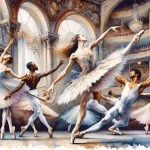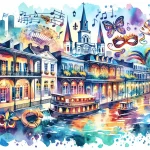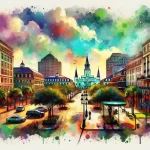New Orleans, a distinctive city brimming with artistic excellence, showcases an impressive array of performing arts organizations that contribute to its unique cultural fabric. From world-class opera and ballet to intimate theater productions, these organizations highlight the city’s diverse talents and traditions. With over 65 performing arts organizations in the Greater New Orleans area, the city offers an unparalleled cultural experience for both locals and visitors.
In This Article
TL;DR
- New Orleans boasts a thriving performing arts scene, featuring over 65 organizations dedicated to various artistic disciplines.
- Major institutions like the New Orleans Opera Association and the New Orleans Ballet Association play a vital role in preserving and promoting the city’s cultural heritage.
- Visitors can immerse themselves in New Orleans’ performing arts by attending performances, participating in educational programs, and exploring the city’s unique cultural offerings.
Historical Context and Evolution of Performing Arts in New Orleans
New Orleans has a long and storied history of performing arts, dating back to the city’s founding in 1718. The first documented opera performance in America took place in New Orleans in 1796, setting the stage for a rich tradition of musical and theatrical expression. As the city grew and diversified, so did its performing arts scene, incorporating influences from African, Caribbean, and European cultures.
Throughout the 19th and 20th centuries, New Orleans continued to be a hub for innovative and influential artists, from jazz pioneers like Louis Armstrong to literary giants like Tennessee Williams. This cultural melting pot has shaped the city’s performing arts landscape, resulting in a unique blend of traditional and contemporary art forms.
Major Performing Arts Organizations in New Orleans
The New Orleans Opera Association
Founded in 1943, the New Orleans Opera Association is the oldest continuously operating opera company in the United States. The organization’s mission is to provide high-quality opera performances and educational programs to the Greater New Orleans community. Notable productions include classic works like “La Bohème” and “Carmen,” as well as contemporary operas that showcase local talent and themes.
The New Orleans Opera Association also offers a range of community programs, such as the “Opera on Tap” series, which brings opera performances to unconventional venues like bars and restaurants, and the “Opera in the Schools” program, which introduces students to the art form through interactive workshops and performances.
The New Orleans Ballet Association
The New Orleans Ballet Association (NOBA) has been a driving force in the city’s dance scene since its founding in 1969. NOBA presents a diverse range of dance performances, from classical ballet to contemporary and world dance, featuring both local and international artists.
In addition to its performance series, NOBA is committed to dance education and community engagement. The organization offers a variety of educational programs, including the “NOBA Center for Dance,” which provides free dance training to underserved youth, and the “Dance for Parkinson’s” program, which uses dance as a therapeutic tool for individuals with Parkinson’s disease.
Le Petit Théâtre du Vieux Carré
Le Petit Théâtre du Vieux Carré, founded in 1916, is one of the oldest community theaters in the United States. Located in the French Quarter, this intimate theater showcases a mix of classic and contemporary plays, as well as musicals and original works by local playwrights.
Le Petit Théâtre is known for its commitment to community involvement, offering educational programs for children and adults, as well as partnerships with local schools and organizations. The theater also hosts the annual “New Orleans Tennessee Williams Literary Festival,” celebrating the life and work of the renowned playwright who called New Orleans home.
Unique Features of New Orleans’ Performing Arts
One of the defining characteristics of New Orleans’ performing arts scene is the integration of local culture and traditions into performances. From the incorporation of jazz and blues music in opera and ballet productions to the use of local dialects and themes in theater, the city’s arts organizations celebrate and preserve its unique cultural heritage.
Collaboration between different arts organizations is another hallmark of the New Orleans performing arts community. Joint productions, cross-disciplinary performances, and shared resources are common, fostering a spirit of creativity and innovation.
Performing arts also play a significant role in New Orleans’ famous festivals, such as the New Orleans Jazz & Heritage Festival and the French Quarter Festival. These events showcase the city’s diverse musical and theatrical talents, attracting visitors from around the world.
Engaging with the Performing Arts: A Visitor’s Guide
To fully immerse yourself in New Orleans’ performing arts scene, plan your visit to coincide with the cultural season, which typically runs from September through May. During this time, major organizations like the New Orleans Opera Association and the New Orleans Ballet Association offer a full schedule of performances.
When purchasing tickets, consider exploring beyond the main stage productions. Many organizations offer smaller, more intimate performances in unique venues, providing a different perspective on the art form. Additionally, look for special events and festivals that showcase the city’s performing arts, such as the “Fringe Festival” in November or the “New Orleans Shakespeare Festival” in the summer.
To make the most of your experience, arrive early to performances and take advantage of pre-show talks or behind-the-scenes tours offered by some organizations. These events provide valuable context and insight into the productions and the artists involved.
Educational and Community Outreach Programs
New Orleans’ performing arts organizations are deeply committed to education and community outreach. Many offer educational programs for students of all ages, from in-school workshops and performances to summer camps and youth ensembles.
For example, the New Orleans Opera Association’s “Opera in the Schools” program brings live opera performances and interactive workshops to local schools, introducing students to the art form and its history. Similarly, the New Orleans Ballet Association’s “NOBA Center for Dance” provides free dance training to underserved youth, nurturing the next generation of dancers and choreographers.
Visitors can often observe or participate in these educational programs, gaining a deeper understanding of the organizations’ community impact and the role of the arts in shaping young lives.
Economic and Social Impact of Performing Arts in New Orleans
The performing arts are not only a vital part of New Orleans’ cultural identity but also a significant contributor to the local economy. According to a study by the Arts Council New Orleans, the nonprofit arts and culture sector generates over $300 million in annual economic activity and supports more than 8,000 full-time equivalent jobs in the city.
Beyond their economic impact, performing arts organizations play a crucial role in community building and social cohesion. By bringing people together to share in the experience of live performance, these organizations foster a sense of belonging and pride in the city’s unique cultural heritage. They also serve as a bridge between different communities, promoting understanding and dialogue through the universal language of the arts.
New Orleans’ thriving performing arts scene also contributes to the city’s international reputation as a cultural destination. The high caliber of performances and the unique blend of influences attract visitors from around the world, enhancing the city’s tourism industry and global profile.
Future Trends and Innovations in Performing Arts
As New Orleans looks to the future, its performing arts organizations are embracing new trends and innovations to engage audiences and push the boundaries of their art forms. One emerging trend is the incorporation of technology into performances, from the use of projection mapping and immersive audio to the creation of interactive, multimedia experiences.
Another trend is the increasing focus on diversity, equity, and inclusion in the performing arts. Organizations are actively working to amplify underrepresented voices, both on stage and behind the scenes, and to create more accessible and inclusive spaces for all members of the community.
In the coming years, New Orleans’ performing arts landscape will likely continue to evolve and adapt, while remaining rooted in the city’s rich cultural traditions. As new artists and organizations emerge, they will build upon the legacy of innovation and creativity that has defined the city’s arts scene for centuries, ensuring that New Orleans remains a vibrant and essential hub of the performing arts.






